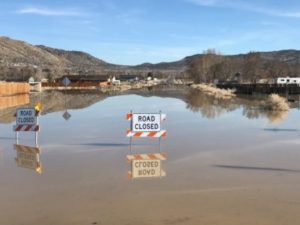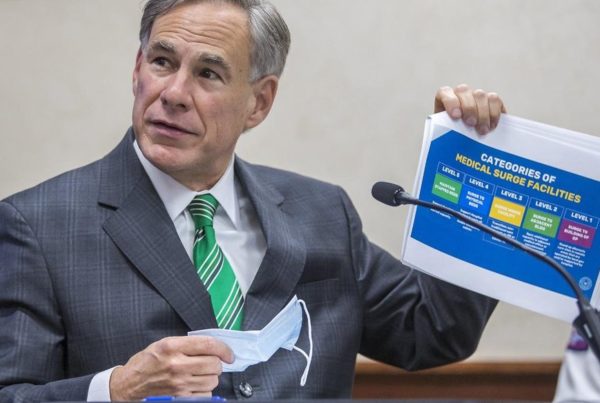From FairWarning:
Homeowners moving into the brand-new Spring Brook Village subdivision in northwest Houston enter their neighborhood through a gate on Preservation Lane. The freshly paved street is lined with tiny saplings, and a sign posted at the entrance displays dozens of little red “sold” labels on a map of the many lots inside. Buyers might have been persuaded by the attractive single family townhouses, two-car garages and the seller’s promise of “clear pricing and no surprises.”
But what might surprise them is that before it became a neighborhood, this land was smack in the 100-year floodplain—limiting the development potential. During big storms in hurricane-prone Houston, a gully just north of the neighborhood often overflows, and water runs through the area “in a sheet,” according to one expert. Thousands of homes near the gully flooded in 2017’s Hurricane Harvey, the Houston Chronicle reported.
So before real estate developer MetroNational put the land on the market, it did what U.S. developers routinely do: it made a request to change the federal flood map. In July 2015, over objections from community members, the Federal Emergency Management Agency approved it. The land was no longer deemed to be in the floodplain, and building eventually commenced on hundreds of homes.
Across the country, developers regularly use flood map changes to build in areas vulnerable to flooding after getting FEMA to approve measures such as elevating homes, building retention ponds and raising the land with fill. FEMA requires such changes if development will raise the flood level in the floodplain by more than a foot. From October 2019 through September 2020, FEMA considered 3,128 map change requests that involved developers using fill, an agency spokesperson told FairWarning. About 90 percent were approved.
But flood experts and community groups argue that promises from developers and permission from FEMA are not always enough to prevent flood risk. In many cases, they say, these former floodplains can also increase the risk nearby. The problem is even more urgent against a backdrop of increased heavy rains and more intense flooding across much of the United States, aggravated by climate change.
Developers often use FEMA map changes to “maneuver around floodplain management standards,” said Joe Rossi, a flood specialist with insurance company RogersGray who serves as a consultant to the National Flood Insurance Program and co-chairs the National Flood Association’s legislative committee. “The result is developed areas with increased flooding.”
In the case of the Houston subdivision, the land had previously been a golf course. In Texas in 2016, there were restrictions on using fill for housing construction in the 100-year floodplain. So to make the land more attractive to potential buyers MetroNational hired engineering firm Jones & Carter to generate new flood models of the area to submit to FEMA with the request for a map change.
According to an investigation by the community group Residents Against Flooding, Jones & Carter used false information to get the map change. For example, the residents claim the model the engineering firm generated showed a nonexistent channel funneling water uphill to prevent floodwaters from ever reaching Preservation Lane.
“This is pretty frightening,” said Steven Emerman, a consultant and retired Utah Valley University hydrologist hired by the group to review its research, in a presentation to flood victims. “How do we ever know when the FEMA flood zone map is based on science and when it’s been revised to suit needs of a developer?”
A FEMA spokesperson said the agency “found nothing false or fraudulent” in the map change after re-reviewing it. They also emphasized that there are opportunities for community input on map change requests.
MetroNational declined to comment to FairWarning on the residents’ claims. The engineering firm didn’t respond to requests for comment. A Meritage Homes spokesperson said in an email that all 900 homes planned for the community “are being built outside of the revised flood plain.”
Developers elsewhere also rely on FEMA map changes to build in flood prone areas.
Despite the 2019 “bomb cyclone” in Nebraska that caused more than $2.5 billion in flood damage, “People migrate to our rivers. They want to live by them,” said Katie Ringland, the state’s chief of floodplain manager and National Flood Insurance Program coordinator.
When developers in Nebraska build in the flood hazard areas, she said, “they’ll elevate it one foot [with fill dirt]. Then they’ll get it outside of the floodplain” with a request for a FEMA map change.
Just because the land is technically removed from the floodplain, Ringland still advises residents whose properties were removed from the floodplain to carry insurance.
Joe Rossi, the flood specialist with insurance firm RogersGray, agrees.
“It’s obviously troublesome when somebody’s two inches above the flood elevation to say ‘Oh you don’t need flood insurance’,” he said. “The requirement’s not there, but now your flood insurance is cheaper and you should definitely continue to purchase it.”
For its part, the National Association of Home Builders has no blanket policy on changing flood maps, said Tamra Spielvogel, who heads the organization’s environmental policy program.
“If a local government deems an area fit for residential building,” she added, flood insurance and mitigation measures allow people to live “in a location of their choice, even when the home lies in or near a floodplain.”
There are non-controversial reasons to request a FEMA map change. Individual homeowners might do it to avoid the priciest flood insurance rates if the flood maps didn’t pick up, for example, that their property sits on a minor land elevation.
But, said Rossi, larger-scale map revisions are generally aimed at making more development possible. “I don’t think I’ve ever seen a [map revision request] that proposes” expanding the flood zone, he said, “because that usually goes against the goal.”
FEMA has a history of altering its maps for the benefit of high-dollar real estate. A 2014 NBC News investigation uncovered more than 500 instances of FEMA removing waterfront properties along all three U.S. coasts from the highest-risk flood zone, cutting owners’ insurance premiums by up to 97%. In 2017, the Department of Homeland Security’s Office of Inspector General found in an audit that the agency needed to improve its oversight of flood mapping programs.
Environmentalists and community coalitions such as Higher Ground have long opposed map changes based on elevating land with fill, arguing that it disrupts ecosystems and amplifies flood runoff, endangering neighboring areas.
In 2000, Frank Thomas, former deputy associate director of FEMA’s mitigation directorate, recommended barring flood map changes for developments that use fill. He called it “egregious,” and akin to “a cancer eating at the foundation” of the National Flood Insurance Program. Thomas argued that the use of fill merely displaced flood risk to surrounding communities, “who, unaware, accrue the transferred flood risk without receiving protection from or compensation for the additional risk.”

A flooded roadway in Lemmon Valley, Nevada, in 2017.
Nevada resident Tammy Holt-Still fears that’s what will happen with the new development proposed in her rural community of Lemmon Valley. In this closed-in basin north of Reno, snowmelt from nearby mountains funnels down to town. In times of heavy rain, a shallow playa called Swan Lake in the middle of Lemmon Valley fills up and floods the surrounding neighborhoods.
It happened in 2017, when a string of nine rainstorms caused millions of dollars in damage and wrecked dozens of homes. Victims had to live in trailers, bought porta-potties to replace their damaged bathrooms and live still in houses with sinking foundations and walls separated from ceilings. The floodwater had nowhere to go, and much of it still stands today.
The Reno Gazette Journal later found that overdevelopment contributed to increased water volume in Swan Lake after local officials ignored recommendations to implement flood mitigation projects. Today, a major housing and industrial development called Prado Ranch is planned for more than 1,500 acres of Lemmon Valley—including parts that are still underwater.
The developer, Lansing Companies, initiated a FEMA map change based on plans that included the use of fill. Holt-Still, a member of a resident group called the Lemmon Valley Swan Lake Recovery Committee, wrote the group’s report opposing it.
“To get [the land] out of the flood plain means they’ve got to bring in fill,” she told FairWarning, essentially creating “a wall” of elevated homes in front of her own. “When the water comes down the hill and towards the lake, the water is not going to have any place to go except to backwash onto my property.”
Flood map change requests are required to include sign-off from local officials, who may or may not listen to the residents who are most affected.
Despite pushback from local groups like the Lemmon Valley Swan Lake Recovery Committee, the city’s director of public works signed off on the community acknowledgement form for the Prado Ranch map change request. But local officials believe the developer never sent it to the agency. Lansing Companies did not respond to interview requests, but city officials told FairWarning they expect the developer will submit a new map change request.
Back in Houston, once the flood map was revised to bring the old golf course out of the floodplain, the builder used fill for construction. Meritage Homes told FairWarning that its fill was excavated from the site itself, and said that its 26-acre drainage system will handle as much water as the golf course did.
Meanwhile, groups like Residents Against Flooding are increasingly hiring experts like Steve Emerman, the retired hydrology professor. Though he started his consulting firm working with South American communities affected by mining projects, he has a growing list of U.S. clients concerned about development in floodplains.
“They’re all versions of the same story,” Emerman said. “Taking someplace that’s currently wetland or forest, putting a development on it, putting in fill dirt, and raising the area a few feet with the clear potential to flood out the neighbors, and denying that.”
This story was produced by FairWarning (www.fairwarning.org), a nonprofit news organization based in Southern California that focuses on public health, consumer, labor and environmental issues.















